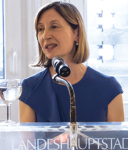Revolutions in medicine always start with the non-medical, with discoveries that seem far afield. Because they are.
Dr. Smith developed phage display.12 Bacteriophages, as you remember from medical school, are viruses that infect bacteria. Dr. Smith learned how to use bacteriophages to characterize protein interactions with other molecules. Although the specifics of the technique are well beyond my undergraduate biochemistry degree, the basic principle is more straightforward: A DNA fragment encoding the protein of interest is inserted into the phage genome, so the protein is expressed on the surface of the virus. Various proteins or other targets of interest are attached to the bottom of plates and put into contact with the phage. If the phage protein sticks to the target, you have identified a significant interaction. If you started with multiple DNA fragments, you can then harvest the phage to identify the relevant DNA fragment.
Dr. Winter used the technique to solve problems—in this case, the problem of the monoclonal antibody. At the time, monoclonal antibodies existed, but were derived from mice and were, therefore, highly immunogenic. The development of the half-mouse, half-human chimeric monoclonal antibody was a workaround that led to the development of infliximab. Dr. Winter used the phage display technique to identify a fully human anti-tumor necrosis factor monoclonal antibody, which led to D2E7, which you may know by its other name, adalimumab.13
Since then, this technique has been used to develop belimumab and a host of monoclonal antibodies under development for the treatment of a variety of diseases. As our understanding of the pathogenesis of our diseases deepens, this technique will increase in relevance to us, and to our patients.
As you may have guessed by now, the point of this discursive story is less to discuss the Nobel Prize in Chemistry and more to illustrate the meandering, non-
linear path of discovery. The funding agency that initially supported Dr. Smith’s work on bacteriophages could not have possibly foreseen that his work would lead to the drug I now give to my patients with rheumatoid arthritis. The true story goes back even further: While studying infectious diseases in India, it was Ernest Hankin who discovered a compound in the Ganges that seemed to kill cholera. Félix d’Hérelle concluded this compound must be a “virus parasitic on bacteria,” which he named a bacteriophage.14 Without Mr. Hankin’s work in India, adalimumab and belimumab might not exist today.
The story of Alfred Nobel and the Nobel Prize shows the role serendipity plays in events we now take for granted. It must have been providence that placed Mr. Nobel’s factories near a deposit of diatomaceous earth, which was the perfect stabilizing agent for nitroglycerin. Also, none of the original clients of Alfred Nobel & Company could possibly have suspected the money they had paid Mr. Nobel for gunpowder and dynamite would eventually fund a prize for chemistry or medicine or peace.
Serendipity and discovery, of course, will take you only so far. Someone must have paid for Mr. Hankin to travel to India. Similarly, without the fortune produced with dynamite, Mr. Nobel’s noble intentions would have been for naught. As research agencies continue to tighten their belts, it has not escaped anyone’s notice that we now tend to fund incrementalism. Shrinking budgets have made the National Institutes of Health risk-adverse, so more than ever, funding dollars go to support established investigators who are building upon their previous work.15
It’s hard not to bet on a sure thing, but it is equally hard to wonder what amazing advances we will never make because of this overly cautious approach. There is a non-linear path from discovery to invention, from the theoretical to the practical. Revolutions in medicine always start with the non-medical, with discoveries that seem far afield. Because they are. For-profit entities will never fund this sort of research; epoch-making discoveries are the province of basic science research that is publicly funded. Only by seeing the sciences as a national priority can we hope to fuel the next, explosive advance.

